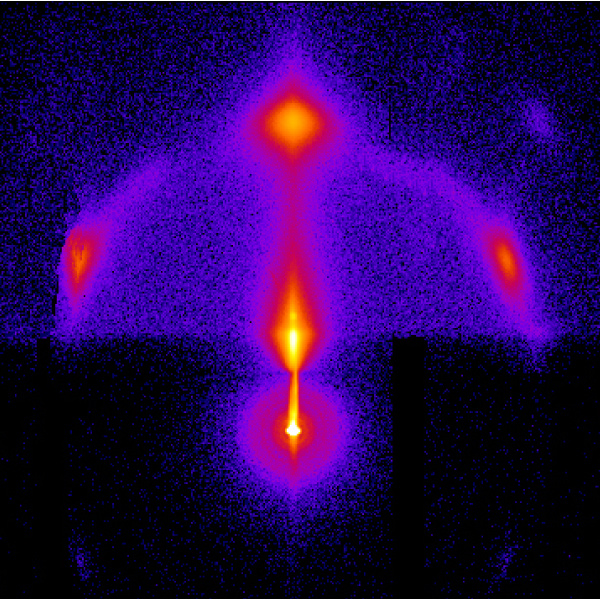The X-Ray Diffraction SEF contains a suite of 6 diffractometers and 1 fluorescence spectrometer for analysis of polycrystalline samples, coatings, epitaxial thin films, nanostructured samples, polymers, and single crystals. The assortment of equipment has been selected to provide flexibility so that we can accommodate a wide variety of demanding research.
For more information about the X-Ray facility, please click here.

CONTACT
Dr. Charles Settens, SEF Operations Manager
office 13-4009 A
phone (845) 430-2584
email settens@mit.edu
Dr. Corey Fucetola, Technical Associate II
office 13-4017
phone (617) 388-6028
email fucetolc@mit.edu
LOCATION
Instrument Lab: Building 13, Room 4027(4th floor)
Computer Lab: Building 13, Rooms 4041 (4th floor)
INSTRUMENTS
Panalytical Multipurpose Diffractometer
This diffractometer can be used to collect XRPD, GIXD, XRR, and residual stress data. Some texture analysis is also possible. Sample sizes may be as large as 60mm diameter by 3-12mm thick, though a more typical sample size is 10-20mm diameter. Data collection modes can be changed between high-speed high-resolution divergent beam diffraction and parallel beam diffraction. There are several accessories for this instrument, including an X'Celerator position sensitive detector, a furnace for in-situ high temperature measurements, a cryostat for in-situ low temperature measurements, a diffracted beam monochromator, and a 15-position automatic sample changer.
Rigaku Smartlab Multipurpose Diffractometer
This diffractometer features a 9kW rotating anode X-ray source, which produces a much higher intensity beam than sealed tube anodes. It is capable of performing most common XRD measurements as well as many uncommon ones, and can rapidly switch between various optical configurations including both Bragg-Brentano and Parallel-Beam geometries. It is suited for XRPD, XRR, GIXD, HRXRD, reciprocal space maps (RSMs), in-plane pole figures, and in-plane grazing incidence XRD scans. Accessories for this instrument include:
- Incident-beam Ge (022) double bounce monochromator, diffracted-beam graphite monochromator
- D/teX Ultra linear position sensitive detector furnace, capable of heating to 1400°C in air, inert gases, or vacuum
- Capillary stage used to hold and spin capillaries of various diameters for data collection in transmission mode
- Battery cell designed to charge and discharge Li-ion based battery materials in-situ.
- In-plane arm which allows the point detector to traverse more than a quarter hemisphere around the sample
Bruker D8 High Resolution Diffractometer
Uses a conventional 1.6kW sealed tube copper anode, and the X-rays are reflected off a parabolic graded multilayer mirror to produce a parallel beam. This instrument features a four-bounce Ge (022) incident beam monochromator. This optic produces highly monochromatic X-rays, eliminating all incident wavelengths except Cu Kα1 (λ =1.540562 Å). The goniometer is a chi-cradle type, with full phi axis rotation and x-y-z translation. Including omega, this gives six positioning axes for the sample (not including the detector axis, 2Theta). Two detectors are mounted on this instrument: a point detector, which offers higher resolution at the cost of speed, and a faster but lower-resolution linear position-sensitive detector. Popular applications include HRXRD, reciprocal space maps (RSM), and XRR.
Bruker D8 GADDS Multipurpose Diffractometer
The Bruker General Area Detector Diffraction System (GADDS) instrument permits collection of diffraction data over a 2theta range -15 to 117 degrees and a chi (tilt) range as large as 30 degrees. The Eulerian ¼ cradle, which permits many unique tilts and rotations of the sample, with a very fast two-dimensional area detector. This configuration makes this instrument ideal for texture and stress measurements, as well as traditional XRPD and limited SCD and GIXD. A selectable collimator, which conditions the X-ray beam to a spot with a size from 0.5mm to 0.05mm diameter, combined with a motorized x-y stage permits micro-diffraction for multiple select areas of a sample or mapping across a sample's surface. Samples can include thin films on wafers or dense pieces up to 6" in diameter (maximum thickness of 3 mm), powders in top-loaded sample holders or in capillaries, dense pieces up to 60mm x 50mm x 15mm (and maybe even larger). In addition, the GADDS system can collect basic WAXS, SAXS, and GISAXS data by configuring the instrument with a collimator-mounted or detector-mounted beam stop and a helium purged flight tube to reduce air scatter.
Back Reflection Laue Diffractometer
This system uses a two-dimensional multiwire detector to collect back-reflection Laue patterns to determine the orientation of large single crystals and thin film single crystal substrates.
Bruker Tracer-III SD Portable XRF
This energy dispersive X-ray fluorescence (ED-XRF) unit provides rapid qualitative non-destructive elemental analysis. It features a rhodium X-ray source and a silicon-based detector and is capable of identifying most elements heavier than magnesium in three minutes or less with a spectrum from 1-40 keV. Normally it gives qualitative results, e.g. trace element identification and relative comparisons of similar samples. Quantitative analysis is possible but more difficult, because the user must create a set of calibration standards for each element of interest.
SAXSLAB Small Angle X-ray Scattering System
The SAXSLAB instrument is setup to perform transmission small or wide angle X-ray scattering on freestanding samples, powders prepared in kapton tape, liquids in disposable or resealable capillaries, gels in sandwich cells with mica windows. Also, there is capability to perform grazing incidence small or wide angle X-ray scattering (GI-SAXS/WAXS) on nanostructured surfaces. The instrument uses a Rigaku 002 microfocus X-ray source with an Osmic staggered parabolic multilayer optics to focus the beam crossover at the second pinhole. It has two sets of JJ X-ray 4 jaw collimation slits that are tunable from 0.02 to 1 mm and are made of single crystal to reduce slit scattering effects. Samples are introduced into a large vacuum chamber that is pumped down to 0.08 mbar. The sample stage has x-y travel and theta tilt for grazing incidence SAXS measurements. The DECTRIS PILATUS 300K detector has the capability of automatically moving from 100 mm to 1500 mm depending on the sizes that are indented to be probed; for WAXS (3-70 Å) and for SAXS (30-2300 Å).
